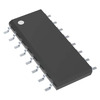Manufacturer Part Number
UCC28950TPWRQ1
Manufacturer
Texas Instruments
Introduction
Integrated power management controller for automotive applications with advanced control features.
Product Features and Performance
Supports Step-Up/Step-Down functionality
Full-Bridge topology with six outputs
Operates across a wide voltage supply range (8V ~ 17V)
High switching frequency capacity (50kHz ~ 1MHz)
Maximum duty cycle of 95%
Incorporates Synchronous Rectifier for improved efficiency
Features Clock Synchronization
Product Advantages
Enhanced control via Dead Time Control, Enable, Frequency Control, Soft Start
High-temperature operational range, suitable for automotive environments
Qualification to AEC-Q100 standards for automotive reliability
Surface Mount technology enabling more compact design
Key Technical Parameters
Output Type: Transistor Driver
Output Configuration: Positive
Number of Outputs: 6
Output Phases: 1
Duty Cycle (Max): 95%
Frequency - Switching: 50kHz ~ 1MHz
Voltage - Supply (Vcc/Vdd): 8V ~ 17V
Quality and Safety Features
Operational temperature range from -40°C to 105°C
AEC-Q100 qualified indicating reliability in automotive applications
Compatibility
Mounting Type is Surface Mount
Package / Case is 24-TSSOP
Application Areas
Automotive power systems
Power Regulation for Electronic Control Units (ECUs)
Power supply for infotainment systems
Product Lifecycle
Status: Active
Not indicated as nearing discontinuation
Availability of replacements or upgrades to be determined based on manufacturer's updates
Several Key Reasons to Choose This Product
Versatility in handling step-up and step-down voltage regulation
High-frequency switching capability for efficient power conversion
Engineered specifically for the demanding automotive environment
Full compatibility with synchronous rectification for power-efficient operation
Features enabling precise control and customization of power supply parameters
Meets stringent quality standards, ensuring robust performance in harsh conditions
Designed for easy implementation into a variety of surface mount technology (SMT) applications




 UCC2894DRTexas InstrumentsIC OFFLINE SW MULT TOP 16SOIC
UCC2894DRTexas InstrumentsIC OFFLINE SW MULT TOP 16SOIC UCC2894PWRTexas InstrumentsIC OFFLINE SW MULT TOP 16TSSOP
UCC2894PWRTexas InstrumentsIC OFFLINE SW MULT TOP 16TSSOP UCC2895NTexas InstrumentsIC OFFLINE SW FULL-BRDG 20DIP
UCC2895NTexas InstrumentsIC OFFLINE SW FULL-BRDG 20DIP